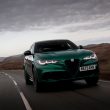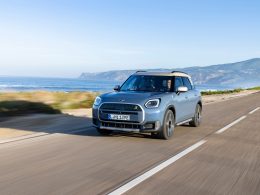TONIO DARMANIN drives the new Hyundai Tucson.
The all-new Tucson is the fourth generation of Hyundai’s successful best-seller with more than seven million units sold around the globe since it launched in 2004. Of these, 1.4 million units have been sold in Europe. That makes it the company’s bestselling SUV globally. Hyundai’s new compact SUV arrives on the market with a revolutionary and ambitious new look that follows the company’s Sensuous Sportiness design identity.
By offering the most electrified powertrain line-up in the compact SUV segment, including plug-in hybrid, hybrid, and 48-volt petrol and diesel mild hybrid options, the all-new Tucson completes the electrification of Hyundai’s SUV fleet in Europe. It will be produced in several factories worldwide, and will become the third generation of the model to be produced in Europe.
Rather than simply an evolution of the previous generation model, the all-new Tucson represents a revolution for Hyundai in design terms. Overall, it features a bigger and wider body than its predecessor. Its muscular stance combines sharp angles and dynamic proportions with rich surfaces, ensuring a progressive look without compromising on Tucson’s rugged SUV heritage. It is the first fully-changed Hyundai SUV to be developed according to the company’s Sensuous Sportiness design identity.
Prominent geometric patterns known as ‘parametric jewels’ appear throughout the SUV’s design, giving it a progressive character. The most prominent display of these parametric jewels is on the vehicle’s front grille, where parametric hidden lights provide a strong first impression. When the lights are off, the front of the vehicle appears covered in dark, geometric patterns, with no distinction between the signature LED Daytime Running Lights (DRLs), which are seamlessly integrated into the grille.
Thanks to state-of-the-art half-mirror lighting technology, when the DRLs are switched on, the dark chrome appearance of the grille transforms into jewel-like shapes, bringing an eye-catching element to an otherwise sleek appearance.
The seamless integration of state-of-the-art technology provides all-new Tucson customers with an advanced and fully-customisable digital experience. This includes a fully digital, configurable dual cockpit, which consists of a new 10.25-inch open digital cluster and new 10.25-inch AVN-touch screen, which fills the centre of the vehicle. Hyundai’s designers dispensed with physical knobs and buttons, so all AVN and heat, ventilation and air conditioning functions are controlled via touch, making it the first Hyundai model to feature a full touchscreen console.

Apple CarPlay and Android Auto allow customers to mirror the functionality of their iOS and Android smartphones in a simplified and convenient manner. This feature is available wirelessly with the eight-inch Display Audio. Other infotainment and connectivity features on the all-new Tucson include a premium sound system by KRELL for an enhanced listening experience, a wireless charging pad in the centre console, and front and rear USB ports for even more convenience, particularly on long journeys.
This includes Multi-Air Mode technology which consists of a combination of direct and indirect air vents for air conditioning and heating to create a more pleasant indoor environment with more gentle air flow. The three-zone climate control now caters to passengers in the rear seats in addition to occupants in the front of the vehicle. Ventilated seats in the front and heated seats in the front and rear provide further comfort for the driver and passenger alike.
The all-new Tucson stands 20mm longer, 15mm wider, and has a wheelbase that has been increased by 10mm as compared to the previous generation, making it more spacious than ever before. As a result, rear passengers can enjoy 26mm of additional legroom. Meanwhile, boot space has been increased, offering up to 620 litres overall for luggage with the seats up and up to 1,799 litres with the seats folded, depending on the chosen trim and powertrain.

With petrol and diesel, 48-volt petrol and diesel mild hybrid, full hybrid and plug-in hybrid available to consumers, the all-new Tucson offers the widest range of electrified powertrains in the compact SUV segment. On top of the powertrain line-up at launch is the 1.6-litre T-GDI Smartstream hybrid version with an output of 230 PS. Beginning of next year, the line-up will be completed by a powerful plug-in hybrid variant with 265 PS.
I had the opportunity to drive 1.6 CRDi diesel manual in Premium Pack and with optional panoramic roof as well as the hybrid automatic in Style Pack trim. Although they are different cars, particularly from a power point of view, and each has its specific target audience. The self-charging hybrid system works efficiently and the transition between electric and ICE and vice-versa is seamless.
With the previous generations selling primarily on rationality, the new Tucson is more likely to be the vehicle of choice on an emotional level. The exterior styling, the upgraded interior, the cutting-edge technology, great connectivity and high levels of safety all contribute to making this one to consider. I am particularly looking forward to driving the plug-in hybrid version once it arrives.













